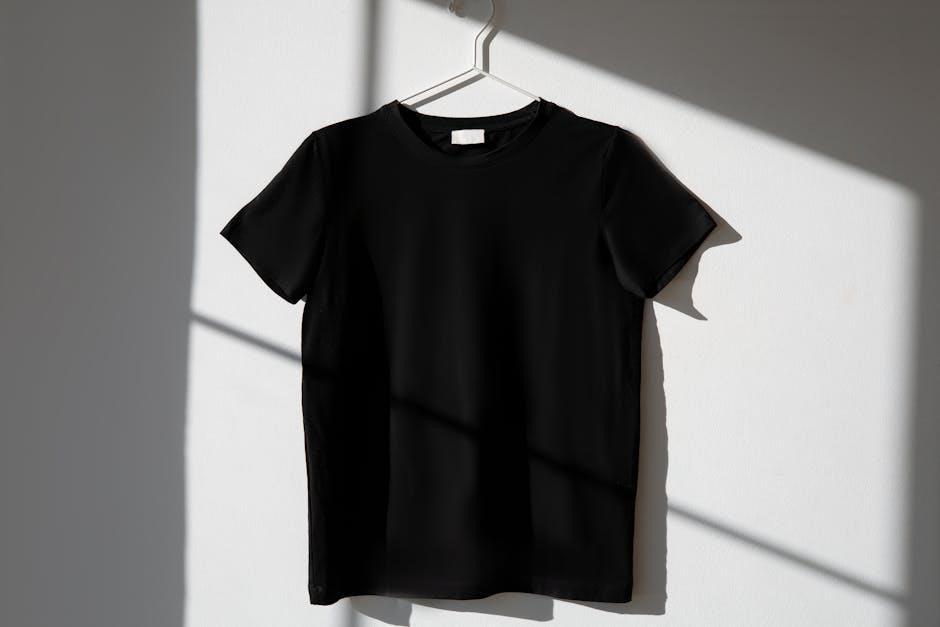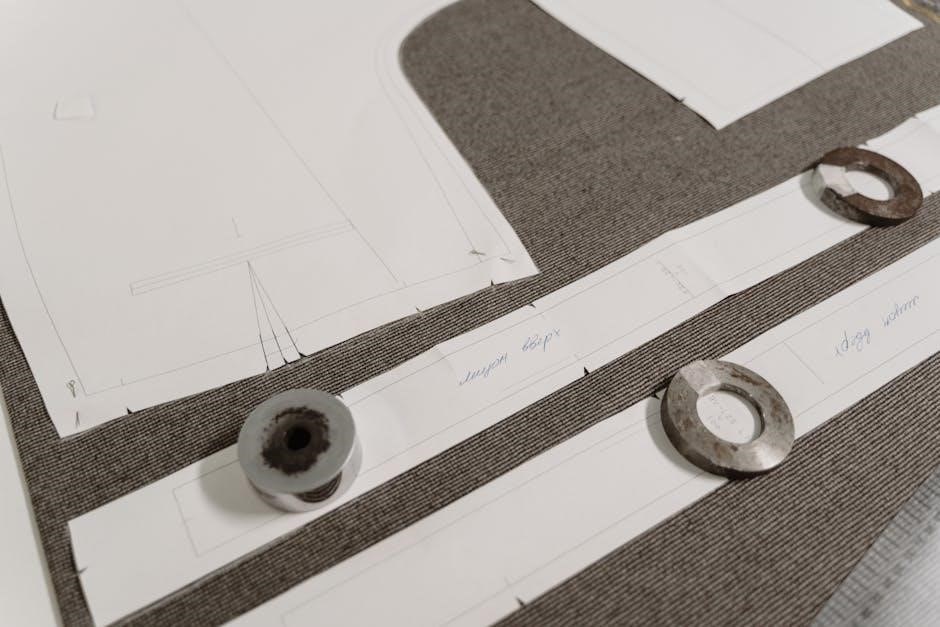
t shirt measurements guide
Understanding T-shirt measurements is crucial for ensuring the perfect fit. This guide helps you navigate size charts, fabric types, and body measurements to find your ideal size effortlessly.
1.1 Importance of Accurate Measurements
Accurate T-shirt measurements are vital for ensuring comfort, style, and satisfaction. Proper sizing prevents issues like tight fits, excessive fabric, or ill-fitting silhouettes. Measuring correctly helps avoid costly returns and ensures confidence in your purchase. Understanding how fabric types impact fit is also key, as stretchy materials may require different sizing than non-stretch ones. By taking precise measurements, you can align your body dimensions with the size chart, ensuring a flawless fit tailored to your preferences and lifestyle. This step is foundational for a hassle-free shopping experience.
1.2 How to Use This Guide
This guide is designed to simplify the process of selecting the perfect T-shirt size. Start by understanding the importance of accurate measurements and how to use size charts effectively. Navigate through sections on measuring your body, fabric types, and garment measurements. Refer to tips for online shoppers and avoid common mistakes like vanity sizing. Use the practical advice provided to ensure a flawless fit, whether you’re shopping online or in-store. This comprehensive guide will help you make informed decisions and enjoy a satisfying shopping experience.

Understanding T-Shirt Size Charts
T-shirt size charts help navigate variations in sizing across brands and styles. Refer to men’s, women’s, and kids’ charts to find your perfect fit effortlessly.
2.1 Men’s T-Shirt Size Chart
A men’s T-shirt size chart typically includes measurements for chest, waist, and body length. Sizes range from Small to 5XL, varying by brand and style. Chest measurements are crucial, as they determine the fit around the torso. Waist measurements are slightly smaller than the chest for a tailored look. Body length varies from regular to long, accommodating different preferences. Fabric type and style, such as slim-fit or oversized, also influence sizing. Always measure a well-fitting shirt to compare with the chart for accuracy. This ensures a perfect fit every time, regardless of the brand or design.
2.2 Women’s T-Shirt Size Chart
A women’s T-shirt size chart provides measurements for bust, waist, and length. Sizes range from XS to 3XL, with variations depending on the brand. Bust measurements are key, as they determine the fit across the chest. Waist measurements are slightly smaller for a flattering silhouette. Body length varies to accommodate different styles, from cropped to long. Fabric type and style, such as slim-fit or relaxed, also impact sizing. Always check the brand’s specific chart, as measurements can differ. Using a well-fitting shirt as a reference ensures accurate sizing and a comfortable fit, regardless of the design or fabric.
2.3 Kids’ T-Shirt Size Chart
Kids’ T-shirt size charts are based on age ranges, typically from 2-3 years to 12-13 years. Measurements focus on chest, waist, and body length, ensuring a comfortable fit for growing children. Sizes are usually labeled as S, M, or L for kids, with variations depending on the brand. Fabric type and style, such as crew neck or fitted designs, influence sizing. Parents should measure their child’s chest and compare it to the chart for the best fit, as sizes can vary between brands and styles.

Measuring Your Body for a T-Shirt
Accurate body measurements are key to finding the perfect T-shirt fit. Measure chest, waist, and body length to ensure a comfortable and flattering garment size.
3.1 How to Measure Chest Size
To measure your chest size accurately, stand upright and wrap a flexible tape measure around the fullest part of your chest. Ensure the tape is level and parallel to the floor, neither too tight nor too loose. For men, this is typically across the nipple line, while for women, it’s usually under the arms and across the bust. Take the measurement while exhaling normally for a natural fit. Compare this measurement to the T-shirt size chart, keeping in mind that sizes can vary between brands. This step is crucial for ensuring a comfortable and flattering fit, whether you prefer slim, regular, or oversized styles. Additionally, consider the fabric type, as stretchy materials may offer more flexibility than non-stretch fabrics. By following these guidelines, you can determine your accurate chest size and select the perfect T-shirt size with confidence.
3.2 How to Measure Waist Size
To measure your waist size, wrap a flexible tape measure around your natural waistline, typically just above the belly button. Stand upright and ensure the tape is snug but not too tight. For accurate results, exhale naturally and avoid slouching. The waist measurement helps determine how the T-shirt will sit, especially for styles like slim-fit or oversized. This measurement is crucial for achieving a balanced fit, as it influences how the shirt drapes and fits around your torso. Always refer to the size chart for guidance. Remember, waist size can vary slightly depending on the brand and style, so double-checking ensures the best fit. This step, combined with chest measurement, provides a comprehensive understanding of your T-shirt size needs. By following these guidelines, you can select a T-shirt that aligns with your desired style and comfort level. Accurate waist measurement is essential for both aesthetic appeal and comfort.
3.3 How to Measure Body Length
To measure body length for a T-shirt, start at the center back of your neck, just below the base, and measure straight down to your desired hemline. Stand straight and keep the tape measure level. For a fitted look, measure to your hipbone, while for a longer or oversized fit, extend the measurement to your mid-thigh or beyond. This ensures the T-shirt hangs comfortably without being too short or overly long. Accurate body length measurement is key to achieving your preferred style and comfort. Always double-check your measurements for consistency. This step, combined with chest and waist measurements, guarantees a well-fitted T-shirt that aligns with your personal style preferences. By carefully measuring your body length, you can ensure the perfect balance between aesthetics and comfort. This measurement is particularly important for taller individuals or those who prefer a specific fit. Ensure the tape isn’t too tight or loose, as this can skew the results. Remember, body length varies by brand, so consulting the size chart is essential for accuracy. This guide provides a clear, step-by-step approach to measuring your body length effectively.

Impact of Fabric Type on Measurements
Fabric type significantly affects T-shirt fit and drape. Stretchy fabrics like spandex provide flexibility, while non-stretch fabrics like cotton offer a more relaxed fit. Measure accordingly for accuracy.
4.1 Stretchy Fabrics
Stretchy fabrics, such as spandex blends, provide flexibility and a snug fit. These fabrics adapt to body contours, making them ideal for active wear or slim-fit designs. When measuring stretchy fabrics, consider the garment’s recovery rate—how well it returns to its original shape after stretching. This ensures accurate sizing, as stretchy materials can expand significantly. Always refer to the brand’s size chart for stretchy fabrics, as their sizing may differ from non-stretch materials. Proper measurement techniques are essential to achieve the desired fit and comfort.
4.2 Non-Stretch Fabrics
Non-stretch fabrics, like cotton or linen, offer a relaxed fit without elasticity. These materials rely solely on accurate measurements for a proper fit, as they don’t adapt to the body. When measuring non-stretch fabrics, ensure precise chest, waist, and length measurements to avoid a too-tight or overly loose fit. Unlike stretchy fabrics, non-stretch materials don’t mold to the body, making correct sizing crucial for comfort and style. Always check the brand’s size chart to align measurements with the intended fit of the garment.

Measuring a T-Shirt
Accurate T-shirt measurements ensure the best fit. Measure chest width, body length, and sleeve length; Use a tape measure and a flat surface for precise results.
5.1 Chest Width Measurement
To measure the chest width of a T-shirt, lay it flat on a smooth surface. Position the tape measure across the chest, from one armpit seam to the other, ensuring it is level. This measurement helps determine the garment’s fit around the torso. For accurate results, the T-shirt should be buttoned if it’s a polo style. Smooth out any wrinkles to ensure the tape measure lies flat. This step is crucial for achieving the perfect fit and avoiding sizing errors. Always double-check your measurements for consistency and accuracy.
5.2 Body Length Measurement
To measure the body length of a T-shirt, lay it flat on a surface and position the tape measure vertically from the top of the collar to the bottom hem. Ensure the garment is smooth and wrinkle-free for an accurate reading. This measurement determines how the shirt will fit in terms of torso coverage. For longer styles, the length may extend beyond the hip, while shorter styles will sit just above the waistband. Always measure along the centerline to maintain consistency and precision.
5.3 Sleeve Length Measurement
Measuring sleeve length involves laying the T-shirt flat and smoothing out wrinkles. Start from the center back of the neckline and measure to the edge of the sleeve cuff. For short sleeves, this typically reaches just above the bicep, while long sleeves extend to the wrist. Ensure the tape measure follows the outside of the sleeve for consistency. This method applies to both short and long sleeves, with the endpoint varying based on style. Accurate measurement is crucial for ensuring the right fit, especially when shopping online.

Importance of Fit and Style
A well-fitting T-shirt enhances comfort, confidence, and personal style. Understanding fit preferences, whether slim, regular, or oversized, ensures the garment complements your body type and lifestyle perfectly.
6.1 Slim Fit vs. Regular Fit
Slim-fit T-shirts are tailored to hug the body closely, offering a modern, streamlined look. They are ideal for those who prefer a fashionable, form-fitting silhouette. In contrast, regular-fit T-shirts provide a more relaxed, classic style with ample room for comfort. Choosing between the two depends on personal preference, body type, and intended use. Slim fits are great for layering or athletic builds, while regular fits suit casual, everyday wear. Both styles ensure a comfortable and flattering appearance when properly sized.
6.2 Oversized Fit Considerations
Oversized T-shirts offer a loose, comfortable fit, often desired for casual or fashion-forward looks. When choosing an oversized fit, consider how much larger the measurements are compared to your body. Ensure the chest width and body length align with your desired level of looseness. Fabric type also plays a role, as stretchy materials may drape differently than non-stretch ones. Pairing oversized tees with tailored bottoms can create a balanced style. Avoid overly baggy fits that lose shape for a more flattering appearance.

Tips for Online Shoppers
Always check size charts and product descriptions for accurate measurements. Use customer reviews to gauge fit and fabric quality, ensuring a confident purchase without trying it on.
7.1 Checking Size Charts
When shopping online, always refer to the specific size chart provided for each product. Brands vary in sizing, so comparing your measurements to their chart ensures accuracy. Pay attention to details like chest width, body length, and sleeve length. Consider the fit style, whether it’s slim, regular, or oversized. Look for any stretch or fabric type notes, as this affects how the T-shirt will fit. Use customer reviews to validate sizing accuracy and ensure the best fit for your body type and desired style.
7.2 Reading Customer Reviews
Customer reviews provide valuable insights into how a T-shirt fits, feels, and performs. They often highlight whether the garment runs true to size, is oversized, or has shrinkage issues. Pay attention to comments about comfort, fabric quality, and stretch. Reviews can also address specific concerns, like sleeve length or body fit. Use this feedback to validate sizing accuracy and avoid common pitfalls like vanity sizing or ignoring fabric type. Reading reviews from similar body types or preferences helps ensure a more informed purchase decision.

Frequently Asked Questions
Why do sizes vary between brands? How to convert body measurements to garment sizes? These questions are addressed to help you make informed choices. This section provides clear answers to common concerns about T-shirt sizing and fit, ensuring you understand the differences in measurements and how to find your perfect size across different brands and styles, avoiding confusion and frustration.
8.1 Why Do Sizes Vary Between Brands?
T-shirt sizes differ between brands due to varying measurement standards and fit preferences. Some brands use vanity sizing, while others prioritize accuracy. Fabric types and styles, like slim-fit or oversized, also impact sizing. Additionally, regional differences in body types influence size charts. This inconsistency makes it essential to check each brand’s specific size chart to ensure the best fit, as relying on generic labels can lead to disappointment. Always measure yourself and compare with the brand’s guidelines for accuracy.
8.2 How to Convert Measurements to Garment Sizes
To convert your body measurements to garment sizes, start by accurately measuring your chest, waist, and body length. Compare these measurements to the brand’s size chart, as sizing standards vary. For example, if your chest measures 40 inches, you may fall into a large or extra-large depending on the brand. Consider fabric stretch and desired fit style (slim, regular, or oversized). If your measurements fall between sizes, size up for comfort. Always refer to the specific brand’s guidelines for the most accurate fit.

Visual Aids for Understanding Fit
Visual aids like size charts and fit models help clarify measurements and fabric impact. Referencing these tools ensures a better understanding of how garments will fit your body.
9.1 Using Size Comparison Charts
Size comparison charts are essential tools for determining the perfect fit. They allow you to compare your measurements with standard sizes, ensuring accuracy. These charts typically include chest, waist, and length measurements, providing a clear reference point. By aligning your body measurements with the chart, you can easily identify your size. Additionally, many charts include visual aids, such as diagrams or fit guides, to help you understand how the garment will fit. Using these resources can significantly reduce the risk of sizing errors and ensure a more accurate fit.
9.2 Referencing Fit Models
Referencing fit models is a practical way to visualize how a T-shirt will look on your body. Many brands use models with varying body types to showcase different fits, such as slim, regular, or oversized. By comparing your measurements and body type to the models, you can better understand how the garment will fit. This method helps minimize sizing errors and ensures the style aligns with your preferences. Look for fit models on product pages or size charts to guide your selection and achieve the desired look. This approach enhances confidence in your purchase decision.

Common Mistakes to Avoid
Common mistakes include relying on vanity sizing and ignoring fabric stretch; Always check size charts and measure fabrics to ensure accurate sizing and optimal comfort.
10.1 Relying on Vanity Sizing
Relying on vanity sizing can lead to poor fit, as brands often adjust sizes to flatter customers. Always measure yourself or use a well-fitting shirt as a reference. Ignoring actual measurements and relying solely on size labels can result in discomfort or an unflattering appearance. To avoid this, focus on accurate body measurements and compare them to the size chart provided by the brand. This ensures a more precise fit and minimizes the risk of sizing errors. Proper sizing enhances both comfort and style, making it essential to avoid vanity sizing pitfalls.
10.2 Not Considering Fabric Stretch
Ignoring fabric stretch can lead to sizing errors, as stretchy materials fit differently than non-stretch fabrics. Always check the fabric type and its elasticity when selecting sizes. For stretchy fabrics like spandex blends, you may opt for a smaller size, while non-stretch fabrics require precise measurements. Failing to account for fabric stretch can result in a shirt that’s too tight or too loose, compromising comfort and style. Use size charts and measure well-fitting shirts to ensure the best fit for the fabric type.
Accurate T-shirt measurements ensure comfort and style. Consider fabric stretch, check size charts, and measure carefully for the best fit. Happy shopping!
11.1 Final Tips for Perfect Fit
For a perfect fit, always measure accurately and consider fabric stretch. Refer to size charts and customer reviews for guidance. Use a well-fitting shirt as a reference for measurements. Pay attention to style differences, such as slim-fit or oversized designs. Don’t rely on vanity sizing, as sizes vary between brands. Double-check your measurements before ordering, especially for stretchy fabrics. By following these tips, you’ll ensure a comfortable and flattering fit every time you shop for T-shirts.